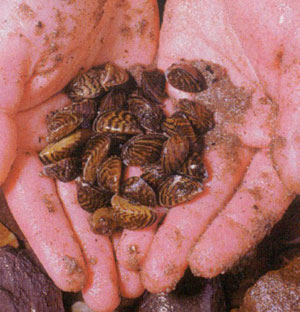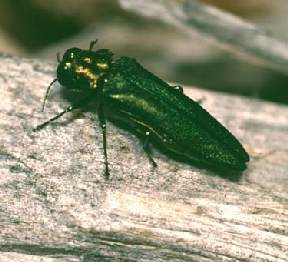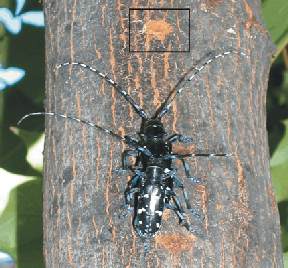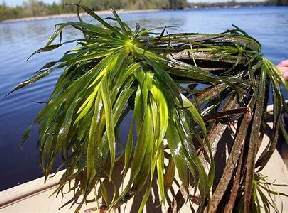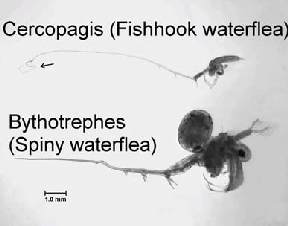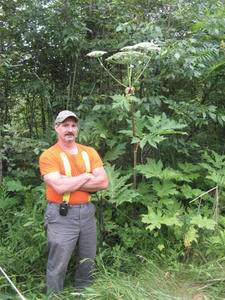The main invasive species and what you can do to help control them
LDD (Gypsy) Moth
LDD Moth, also known as Gypsy Moth
The information below has been provided by the Honourable Greg Rickford, Minister of Northern Development, Mines, Natural Resources and Forestry (MNDMNRF)
February 18, 2022
Ontario is currently experiencing an outbreak of LDD moth (previously referred to as gypsy moth), particularly in southern Ontario and some areas of the northeast region of the province. Severe LDD moth infestations are cyclical, occurring every seven to 10 years, and usually last three to five years.
In the spring and early summer, LDD moth larvae consume leaves, defoliating trees and leaving them looking nearly dead. LDD prefers oak trees, but during severe outbreaks other hardwoods and, in some cases, conifer will be defoliated. Hardwood trees can produce a second crop of leaves during the growing season allowing them to continue growing and storing nutrients into the fall and winter months. Since conifers can’t produce a second crop of foliage, they may be impacted by severe defoliation. Healthy growing trees can withstand a few seasons of severe defoliation before branch and twig dieback start to occur.
In 2021, the Ministry of Northern Development, Mines, Natural Resources and Forestry (NDMNRF) conducted aerial and ground surveys to map damaged areas and forecast defoliation for 2022. The results suggest 2022 will be another year with high populations of LDD moth causing moderate to severe defoliation in some areas. Lighter defoliation is forecasted in some areas that have been impacted in previous years. NDMNRF will continue to monitor LDD moth throughout the current outbreak cycle.
Although the ministry conducts pest management programs on Crown land to protect foliage of high-value stands (e.g., jack pine and spruce budworm programs), management of LDD moth on private land is the responsibility of the landowner or municipality. The ministry supports these efforts by providing information on forest pests and options for reducing defoliation by LDD moth. Ontario’s Invasive Species Centre also offers resources and information to help people prevent LDD moth from damaging their trees.
In the spring, landowners can put bands of burlap around their trees. This gives the larvae a place to congregate during warm days and they can be physically removed and killed. In the fall, landowners can remove and destroy egg masses.
Landowners wishing to reduce impacts on their property can also have trees sprayed with Btk (Bacillus thuringiensis kurstaki) in the spring by a licensed insecticide application company. This is best carried out by coordinating efforts with other local landowners. Landowners can check their local listings for a reputable insect control provider in their area.
In the past, demand for aerial spraying of LDD has exceeded industry capacity. If landowners are considering having their property sprayed, it is best to engage a licensed insecticide application company as early as possible.
There are also natural controls on LDD moth populations in Ontario:
- Cool, wet conditions provide an ideal environment for a natural fungus (Entomophaga maimaiga) known to contribute to LDD moth population collapse.
- A viral infection (nuclear polyhedrosis virus or NPV) also kills LDD larvae.
- There are other natural enemies of LDD moth as well, including parasitic insects and predators such as birds and mammals.
Below are links to a fact sheet and a roles and responsibilities document to help anyone who may have questions about managing LDD moths during the outbreak period.
Zebra Mussels
Zebra Mussels
The best defense against the spread of zebra mussels is to restrict its movement between lakes and rivers. Once they become established in a lake, there is no known way to eliminate them. Here are some precautions to help prevent the spread of zebra mussels and other exotic species:
Inspect your boat, trailer, boating equipment, fishing tackle and nets and remove any visible plants or animals before leaving any lake or river.
Drain water from motor, live well, bilge and transom wells while on land before leaving the boat launch area.
Empty your bait bucket on land before leaving the water body. Never release live bait into a water body, or release animals from one water body into another.
Wash/Dry your fishing tackle, nets, boat and equipment to kill harmful species that were not seen at the boat launch. Some species can survive for several days out of water, so it is important to:
- rinse your boat and equipment with hot tap water ( 50° C); or
- spray your boat and equipment with high pressure water (250 psi); or
- dry your boat and equipment for at least five days, before transporting to another body of water.
For more details see the OFAH web site.
Asian Longhorned Beetle and Emerald Ash Borer
Asian Longhorned Beetle and Emerald Ash Borer
Firewood often contains insects and plant diseases. Cottagers or other visitors who bring firewood from home may accidentally spread those diseases that threaten the health of our forests. The Asian Longhorned Beetle and emerald ash borer are of particular concern. They are both recent arrivals to Canada and without natural controls here.
The emerald ash borer was thought to be confined to southwestern Ontario and southeast Michigan, where it has killed millions of ash trees. But more recently it has been seen in Ottawa, which demonstrates the importance of controlling its spread. The movement of firewood has been the main culprit in its rapid spread in both the U.S. and Canada over the past year. As a result, a quarantine has been imposed which prohibits the movement of firewood in several parts of Ontario. Here in Eastern Ontario we should be taking this risk seriously.
The Asian Longhorned Beetle has been found attacking hardwood trees between Vaughan and Toronto. Both insects can be easily spread in firewood, which may look normal, but still be infested with the insects.
How you can help:
- Do not move firewood, especially firewood obtained from areas under quarantine such as Essex County and the U.S.
- Buy and use only local firewood
- Ask your supplier where their wood comes from
If you have questions call the Canadian Food Inspection Agency at
1-800-442-2342 or visit its website.
Water Soldier Plant
Water Soldier Plant
From an article in the Toronto Star, May 26, 2009
An aquatic invader is camping out on the banks of the Trent-Severn Waterway, and from the sounds of it, is getting very comfortable.
“We have been doing surveillance of this plant; it is the first known sighting in Canada,” said Francine MacDonald, an aquatics biologist at the Ontario Federation of Anglers and Hunters who is an expert in invasive species.
The new undesirable in her sights is called the water soldier, Stratiotes aloides.
It resembles an aloe vera or spider plant, but with one significant difference: “It is very sharp – just to pull it out of the water you have to put gloves on,” said MacDonald.
The Trent-Severn batch was reported by a Hastings area resident last fall. He spotted a handful of the plants in 2007 and tried to weed them out. But the water soldier sprung back. Its ranks have swelled to the hundreds and there is a satellite group of similar size about two kilometers downriver.
Last week, a team went to the site to observe and count the plants.
“From what we have seen, it has become an impediment to boaters,”
MacDonald said. “It could be a huge problem for swimmers.”
Like spider plants, water soldiers have offsets, little plants that detach and take root at new locations, so moving water offers the perfect method for them to spread.
Unfortunately, so are careless gardeners. Water soldiers and many other invasive species can be purchased at Ontario nurseries.
“If you are going to use exotic plants, keep them contained, don’t enable them to escape” by planting them in flood plains or near waterways, said MacDonald.
The biologist said for safety reasons, chemical solutions to repel the invaders are limited. “A lot of times it is very difficult to control aquatic plants … we hope we have found this one early enough.”
Anyone who spots water soldiers in the wild should call the invasive species hotline at
1-800-563-7711. [/toggle]
Spiny Waterflea and Fishook Waterflea
Spiny Waterflea and Fishook Waterflea
The spiny Waterflea feeds on small animal life called Zooplankton. When populations of this invader are high, Zooplankton consumption can be significant. Compared to native Zooplankton species, it eats up to three times as much food. Research on the impact of the spiny Waterflea has shown changes in both the abundance and the diversity of Zooplankton species. However, it is still too early to determine if spiny Waterflea will alter our aquatic ecosystems to the detriment of fish populations.
Fish will feed on spiny water fleas. However, for fish smaller than 10 cm ( 3.9 in ) long, the tail spine of the spiny water flea gets caught in the throat and the organism is literally coughed out. To date, scientists have not observed a decline in the number of small fish due to the fish’s inability to feed on spiny water flea and competition with it for food. However, over time, the possibility of an impact on fish populations is possible.
Spiny water fleas can become entangled in fishing lines and down rigger cables. When the cable is pulled from the water, the spiny water fleas attached to the cable look like straight pins. You may see them raise and lower their tails as they cling to the line.
Prevention
The best defense against the spiny water flea is to prevent its transfer to new lakes or rivers. Spiny water flea eggs and adults can get into bilge water, bait buckets, live wells and coat fishing lines when boating or fishing in infested waters. Please take the following precautions to prevent the spread of spiny water flea and other invading species to different rivers and lakes:
Inspect your boat, trailer, boating equipment, fishing tackle and nets and remove any visible plants or animals before leaving any river or lake.
Drain water from motor, live well, bilge and transom wells while on land before leaving the waterbody.
Empty your bait bucket on land before leaving the water body. Never release live bait into a waterbody, or release animals from one water body into another.
Wash/Dry your fishing tackle, nets, boat and equipment to kill harmful species that were not seen at the boat launch. Some species can survive for several days out of water, so it is important to:
- rinse your boat and equipment with hot tap water (> 50° C); or
- spray your boat and equipment with high pressure water (250 psi); or
- dry your boat and equipment for at least five days, before transporting to another water body;
For more details see the OFAH web site.[/toggle]
Giant Hogweed
Giant Hogweed
From the Pembroke Daily Observer, July 8, 2010
| Giant Hogweed, a dangerous invasive plant, has now been confirmed in Renfrew County. The occurrence was noted in Laurentian Valley Township, and action is being taken to remove it.Giant Hogweed came originally from Asia, and is now firmly established throughout much of southern Ontario.A member of the carrot and parsley family, it is distinguished by its huge size -it can grow up to 20 feet in height, with leaves up to five feet in width.If the sap from a broken stem or crushed leaf, root, flower or seed comes into contact with damp skin (perspiration will suffice) and the skin is exposed to sunlight, severe burns, blistering and painful sores may result.
Even a tiny amount of sap getting into the eyes can result in temporary or permanent blindness. The only known antidote to contact with the sap is immediate, thorough washing using soap and water. Once irritation begins, medical advice should be sought.Those most at risk include road maintenance crews cutting roadside ditches, lawn and garden maintenance laborers and other outdoor workers or recreationalists. The sap can be spread by pets or livestock that have been in contact with the plant, as well. There are a number of distinguishing features that separate giant Hogweed from similar plants. First and foremost is its size -it truly is “giant”. Stems are one to three inches in diameter (sometimes reaching four) and marked with dark purplish blotches or spots and covered with sturdy bristles. The flowers form a flat-topped, umbrella-shaped head up to 2.5 feet wide. The leaves are deeply incised and can reach up to five feet in width. The most common “look-alike” in Renfrew County is cow parsnip, an innocuous native that also likes roadside ditches. It seldom exceeds five feet in height, and the leaves are only two to 2.5 feet across. For more details see the OMAFRA web site. |

